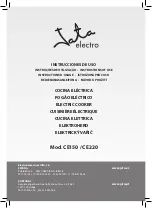
10
EN
BEFORE SETTING SURFACE CONTROLS
Pan Sensing
• Cookware centered correctly
on cooking zone.
• Flat pan bottom and straight
sides.
• Pan rests completely and is
level on the cooktop
surface.
• Pan is properly balanced.
• Pan bottom rests on cooktop
edge.
• Cookware not centered on
cooking zone.
• Curved or warped pan bottoms
or sides.
• Heavy handle tilts pan.
• Cookware base material has
good magnetic characteristics.
• Cookware base material is
non-magnetic.
Magnet
Sticks
Magnet
Falls
Sensors beneath the cooktop surface
require that certain cookware con-
ditions be met before an induction
cooking zone will operate. If a cooking
zone is turned on and conditions are
wrong, the setting in the zone display
will
fl
ash.
Figure 5: Flashing indicator
Figure 6
shows conditions that can generate a
fl
ash-
ing message.
Minimum and Maximum Pan Size
Induction cooking zones require pans of proper
size in order to activate. The cooktop graphics are
guides to minimum and maximum pan size for each
cooking zone.
The inner ring on each cooking zone indicates the
smallest pan size for the zone (Figure 8). If cook-
ware is too small, the display will
fl
ash and the pan
will not heat. Select a larger pan or use a different
cooking zone.
The outer ring on the cooktop graphic indicates the
largest pan size for that zone (Figure 8). Do not use
pans with bottoms that extend beyond the outer
circle of a cooking zone, as doing so may cause food
to heat unevenly.
Correcting Pan Sensing Errors
It is recommended that you lower the requested
power level setting before correcting a pan sens-
ing error, then reset the zone to the desired power
level.
If conditions preventing operation are not corrected,
the cooking zone will automatically turn off after
two minutes.
Figure 6: Pan sensing conditions
Figure 7: Good cookware size
Figure 8: Cookware too small, Cookware too
large











































